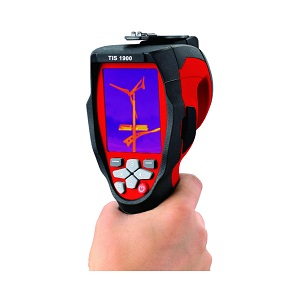Thermography is the practice of using a thermal imaging camera to produce images of heat patterns that are emitted by objects. This is commonly used in industrial situations to detect electrical safety issues with motors, circuits and panels, but can also be used in commercial and domestic buildings to detect energy inefficiencies. The thermal imaging camera identifies areas of high and low heat energy, which helps us to understand where heat loss may be occurring.
Heat loss can account for around 50% of the total energy consumption in a home, so it is very important that we detect problems and deal with them quickly. Air exchange is important for maintaining a comfortable temperature and improving air quality in a home, but too much air loss is inefficient. Using a thermal imaging camera, you can identify small areas of heat loss which otherwise wouldn’t be detectable, or visible to the naked eye, but which over time would contribute to significant heat energy loss.
How does thermal imaging work?
A thermal imaging camera – such as the TIS1900 supplied by Test Instrument Solutions – is a portable hand-held test instrument that is very easy to use. Using a sensor pointed at an object, the camera can detect infrared energy that is emitted by that object and it converts this into a visual image that we call a heat map. We can view this image to identify variations in temperature using the colour spectrum, with high temperatures being red/yellow and cooler temperatures being blue/purple. By pointing the camera at an object from an appropriate distance we can get an instant, accurate reading of the heat energy being emitted from that object, or in the case of a home energy audit, heat that is escaping from an object.
How do we use thermal imaging to detect energy inefficiency in a home?
Using a thermal imaging camera, we can scan the exterior and interior of a property to identify where heat is being lost through poor insulation, or gaps and air leaks around doors, windows, electrical outlets, chimneys or wall vents.
- Where a relatively large area is cool, this could be a lack of insulation or poor insulation
- Where you can detect localised patterns of cold spots in clusters, or where heat energy is distributed in even patterns, this could be a draft
- Take a baseline image under normal conditions which you can then use for comparison purposes to detect changes in heat patterns over time
Benefits of using a thermal imaging camera for energy management in the home
management in the home
Using a thermal imaging camera for identifying home energy inefficiencies is becoming increasingly popular because:
- It is quick and easy
- It gives accurate results and helps to identify small areas of heat loss you otherwise would never be able to detect
- You are able to take readings from hard-to-reach areas such as lofts and basements or high exterior walls, although you do need to agree on an optimal distance to obtain accurate readings
- It is non-invasive and requires no contact with the heat-emitting object
- You can record all your findings for comparison over time, and can download and share them also
Considerations when using a thermal imaging camera for a home energy survey
When using a thermal imaging camera to identify areas of heat energy loss in the home, there are a number of considerations to make in preparation:
- Weather – On a hot day a building will absorb heat energy and therefore could give inaccurate results. You should ideally carry out a thermographic survey early in the morning, in an evening when the sun has disappeared, or simply on a cooler day.
- Glass and metal – Reflective surfaces in glass and metal can reflect heat energy and again, can skew results. So taking readings from these areas in bright sunlight should be avoided.
- Distance – Decide on a distance that gives accurate readings and be consistent with how you carry out the test thereafter, so you can rely on comparable results. The distance you test from can differ between objects, as long as the distance is the same every time you test that object.
Contact Test Instrument Solutions for accurate and reliable thermal imaging cameras
The range of thermal imaging cameras supplied by Test Instrument Solutions is highly respected in the industry, and our products are now used widely in home energy surveys and by landlords managing their Environmental Performance Certificates. The camera is able to identify where home energy improvements can be made, and is therefore a vital tool is managing your home energy usage.
Please note that this section is for information purposes only. Anyone using equipment referred to in this section must be suitably qualified and/or experienced within the respective field. If in doubt before use, please consult a qualified electrician or engineer & thoroughly read all instruction booklets.